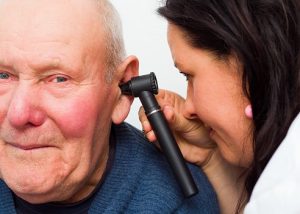You have made that step to book an appointment with an audiologist to learn more about your hearing health. Great! Before you go, it may be helpful to know what to expect during the test.
You can purchase the latest hearing aids at a fair price through HearingSol, If you need any assistance or you have a query regarding Types of Hearing Test or Hearing Loss, feel free to call us at +91-9327901950. We are always here to help you.
Different Types of Hearing Tests
A hearing test is a depth evaluation of the level of hearing, this test is conducted by an audiologist. A Hearing exam not only determines the person’s level of hearing but also the nature of loss as well. According to the result, assistive measures are prescribed as well.

A hearing screening can evaluate how well you can hear the sound which is coming to the inner ear through the ear canal, the ear will be examined with an otoscope. It will help the audiologist to see the blockage in your ear canal.
There are several types of evaluations that your audiologist may choose to perform. The following are common types of hearing loss exams that may be considered. Your hearing professional will probably not conduct all of these tests, they will determine which method is most appropriate for you.
Otoacoustic Emissions Test (OAE)
This test record the sound of the ear that the ear produces itself. The test is performed by a small probe which is placed on the baby’s ear, tones are played which sent from the probe speaker to the ear canal through the middle ear, inside the cochlea. Test include mainly three parts, the inner ear, middle ear, and outer ear. Through these tests, it can determine how well your inner ear, or cochlea, works.
There are hair cells inside the inner ear that respond to the sound by vibration. The vibration produces a very little sound that eco back into the middle ear, the sound which is produced is the OAE that is measured.
If you have hearing loss which greater than 25-30 decibels (dB), you will not produce these very soft sounds. But if you have normal hearing like others, you will produce OAEs.
The OAE test can also display if there is any blockage in your middle or outer ear. If there is a blockage then no sound will able to get through to the inner ear. Which means there will be no vibration or sounds that will come back.
Impedance Testing
These tests determine the proper functioning of the middle ear. It also evaluates the acoustic reflex pathways, which include cranial nerves VII and VIII and the auditory brainstem. Evaluates the integrity of the middle ear system. Loud tones are presented to each ear, to examine whether an acoustic reflex is present or absent, without requiring any response from the patient. This test can be done from 3 to 30 second per ear. It evaluates how well the eardrum is vibrating when the sound strikes.
Impedance testing can measure the pressure of space behind the eardrum which contains those bones. A rubber tip is inserted in the ear and the pressure in the ear canal is changed.
Auditory Brainstem Response (ABR)
This test can be conducted when the baby is sleeping, the three electrodes are placed on the baby’s head, these electrodes are stuck to your skin and connected to a computer. tones are played into little headphones which are placed inside the baby’s ears. It measures the response of the brain on the tone played inside the ear. It determines at which sound the brain actively responding.
This test can be conducted in a few minutes. This test is conducted on children or others who cannot complete a typical hearing screening.
Audiometry Test
This test is conducted in a soundproof room, the person wears a headphone and the audiologist sit outside the room and play the different types of sound. The patients have to respond to the sounds by raising a hand and pressing the button.
An audiologist can examine the patient’s ability to hear sounds at different pitches. The sounds vary and based on their loudness (intensity) and the speed of sound wave vibrations (tone).
Sound waves travel to the inner ear through the eardrum, Hearing occurs when sound waves stimulate the nerves of the inner ear. The sound can also pass through the bones around and behind the ear.
The sound is measured in decibels (dB):
- A whispering sound is about 20 dB.
- The level of loud music (some concerts) is around 80 to 120 dB.
- A jet engine sound level is about 140 to 180 dB.
If the sound is greater than 90 decibels, it can cause hearing loss after a few hours. It can develop in a very short period of time. Louder sounds can cause immediate pain in your ear.
The tone of the sound is measured in cycles per second (cps) or Hertz. The low bass tone can range around 50 to 60 Hz and the high bass sound range around 10,000 Hz or can be higher.
Pure-Tone Test
This testing is performed by putting earphones inside the ear and raising your hand whenever you heard the “beep” sound. This is known as pure-tone testing. The sound goes through the outer and middle ear.
This test helps to examine the quietest sound you can hear at different pitches or frequencies. The ears are tested individually, the result is shown on an audiogram or as a graph.
Pure-tone testing is a behavioral test used to measure hearing sensitivity. It measures the central auditory systems. Degrees of hearing impairment In a normal hearing it is (0–25 dB): At this level, hearing is within normal limits.
Bone Conduction Testing
This type of test is another type of pure-tone test that measures your inner ear’s response to sound. A conductor will be placed behind your ear, it will send tiny vibrations through the bone directly to the inner ear. This is different than the traditional one, which uses air to send audible sounds. If the results of this test are different than the pure-tone test, your audiologist can use this information to determine your type of hearing impairment.
Speech Testing
This test is somehow similar to pure-tone testing But in this testing instead of listening to the different sound. They make you listen to certain words spoken at different volumes, which you are asked to repeat. Instead of pressing a button or indicating with their hand.
The volume may be adjusted throughout this test in order to determine the quietest that speech can be heard half of the time it is given to the patient. Speech test also provides information regarding discomfort or tolerance to speech stimuli and the information on word recognition abilities.
Sometimes these tests are performed in a noisy environment because many people who are suffering from hearing loss have trouble hearing conversations when there are sounds playing in the background.
Speech test helps to assess how well they can hear in a noisy environment. The patients repeat words back to the hearing health professional. It helps to set up a proper treatment plan for the patients as per the requirement.
Online hearing tests are by no means a alternate for a thorough diagnostic hearing evaluation, but they can be a good place to start if you are unsure about making an appointment. Not sure where to start? Visit HearingSol or give us a call on +91-9327901950.

